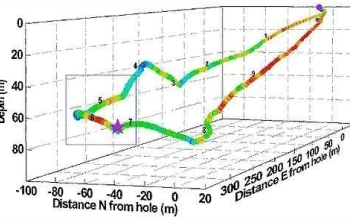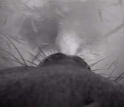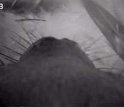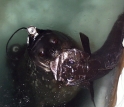News Release 99-007
Video and Data Links Provide "Seal's Eye View" of the World

The swimming path of a 10-minute, 20-second dive during which a Weddell seal ...
February 11, 1999
This material is available primarily for archival purposes. Telephone numbers or other contact information may be out of date; please see current contact information at media contacts.
Imagine a lion, poised to bring down its prey, drawing and holding a breath, then giving chase for 20 minutes. Few, if any, large land-based predators could do such a thing. But seals and other marine mammals regularly do.
Now a team of researchers, supported by the National Science Foundation (NSF), has devised a way to enter the alien world of Antarctic Weddell seals as they hunt. Using a small video system and data logger attached to the seals' backs, they have tracked the animals below the sea ice of McMurdo Sound.
"We can now make observations at depth and relate them to the underwater movements of animals as researchers have done with lions and other large predators for years in terrestrial habitats," said Randall W. Davis, a marine biologist at Texas A&M University, the team leader.
Davis and his colleagues, Terrie W. Williams, of the University of California, Santa Cruz and Lee A. Fuiman, of the University of Texas, describe their techniques in the Feb. 12 edition of Science.
Although others have mounted cameras on marine mammals before, Davis stressed that the value of his research is the simultaneous recording of video, audio and data on swimming performance and environmental characteristics. The data collected enables the researchers to compute the three-dimensional path of individual dives.
"This combination of technologies will allow for major advancements in our understanding of the underwater behavior of marine mammals," noted Polly Penhale, who oversees the U.S. Antarctic Program's biological and medical research.
Davis said that many of the project's scientific findings are preliminary, but intriguing. For example, although Weddells have a known range of vocalizations comprising 34 different sounds, they seldom used sound underwater. This may indicate that the seals do not use echo-location to find their prey.
However, seals, unlike humans, have an exceptional ability to locate the source of a sound underwater. "That sort of 'passive sonar' could be quite important, but it is very hard to verify experimentally," Davis said. The camera also recorded seals apparently using surface light penetrating the ice to silhouette Antarctic cod, a prey species, indicating that visual clues may be important to hunting seals.
The sound and video equipment, he noted, will allow greater insight into the behavior of animals that regularly range up to three kilometers and return safely to a single, four-foot-wide breathing hole. "What captures the imagination of both scientists and non-scientists in this research is the ability to vicariously travel with these animals as they descend to great depths," he stressed.
-NSF-
-
A seal blowing air out of its nostrils and into crevices in the sub-ice platelet ...
Credit and Larger Version -
Moments after the seal finishes blowing air, one of the fish is flushed out ...
Credit and Larger Version -
A Weddell seal, equipped with camera and data recorder, surfaces at a breathing hole ...
Credit and Larger Version
Media Contacts
Peter West, NSF, (703) 292-7761, email: pwest@nsf.gov
Program Contacts
Polly A. Penhale, NSF, (703) 292-8033, email: ppenhale@nsf.gov
The U.S. National Science Foundation propels the nation forward by advancing fundamental research in all fields of science and engineering. NSF supports research and people by providing facilities, instruments and funding to support their ingenuity and sustain the U.S. as a global leader in research and innovation. With a fiscal year 2023 budget of $9.5 billion, NSF funds reach all 50 states through grants to nearly 2,000 colleges, universities and institutions. Each year, NSF receives more than 40,000 competitive proposals and makes about 11,000 new awards. Those awards include support for cooperative research with industry, Arctic and Antarctic research and operations, and U.S. participation in international scientific efforts.
Connect with us online
NSF website: nsf.gov
NSF News: nsf.gov/news
For News Media: nsf.gov/news/newsroom
Statistics: nsf.gov/statistics/
Awards database: nsf.gov/awardsearch/
Follow us on social
Twitter: twitter.com/NSF
Facebook: facebook.com/US.NSF
Instagram: instagram.com/nsfgov





